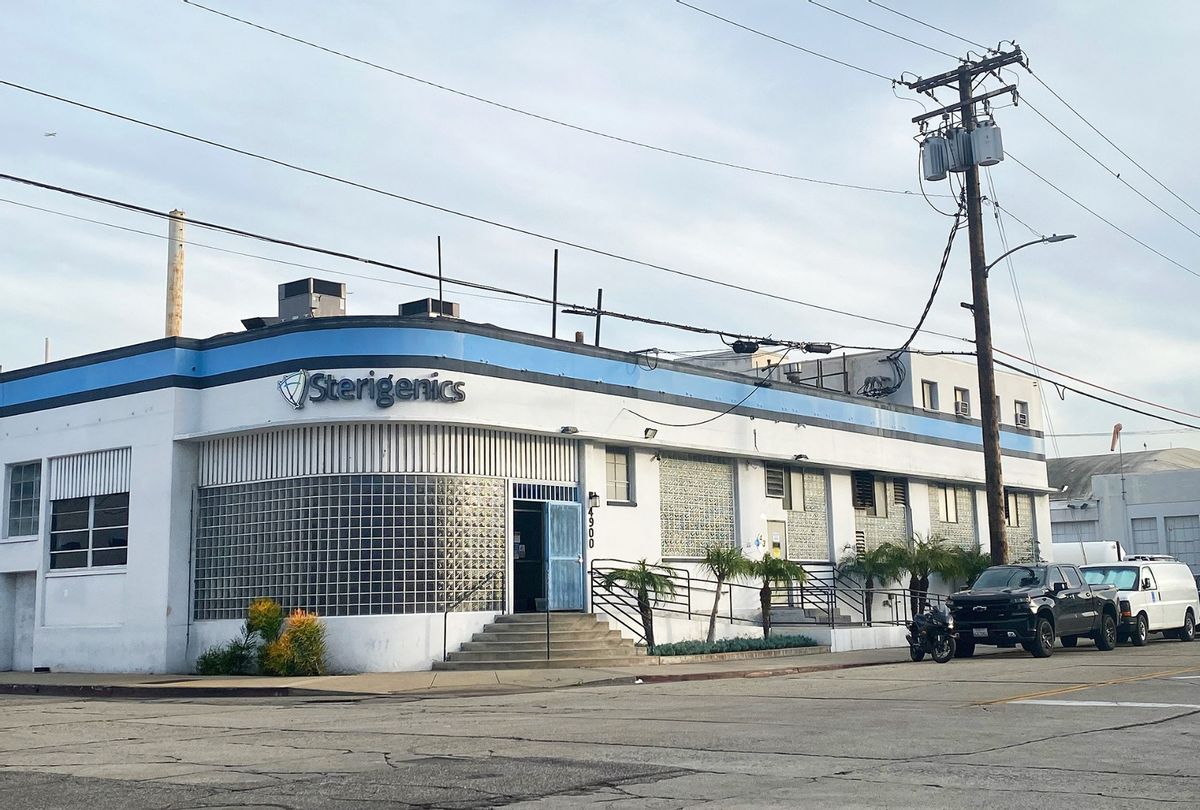The air quality regulator for much of Southern California is risking public health by allowing emissions of ethylene oxide, a highly toxic gas associated with lymphoid and breast cancer, at levels far above the federal cancer risk guidelines for the chemical, warn environmental health experts.
The South Coast Air Quality Management District (AQMD) says that it is bound by law to use health values adopted by the state more than 35 years ago to guide acceptable ethylene oxide emissions at three medical device sterilization facilities in its region. But other experts, including a former AQMD board member, argue that the agency already has the authority it needs to use a far stricter health guideline adopted by the federal EPA in 2016.
The levels of ethylene oxide being released from facilities in Vernon, Carson and Ontario that sterilize medical equipment are "way too high for public health," said Jane Williams, executive director of California Communities Against Toxics, an environmental advocacy group. She said it is "rubbish that South Coast [AQMD] says that they cannot use the more protective emission limits at these sterilizers."
Earlier this year as part of an air monitoring program, the AQMD found that the three facilities were emitting far larger amounts than previously known of the highly toxic colorless and odorless gas, which is used to sterilize medical products. Homes and schools are within blocks of the Carson and Vernon sites. The AQMD set up air monitors around the three plants and required the facility operators to begin the process of installing better pollution control devices. If emission levels rise above certain trigger thresholds at one of the facilities, the plant operators are required to cut emissions by specific amounts within specific timeframes.
Using values calculated by the Office of Environmental Health Hazards Assessment (OEHHA) in 1987, the AQMD has also set health guidelines at these facilities for both off-site workers and nearby residents. Though the latest available data shows that ethylene oxide emissions from all three facilities remain around these guidelines, these levels are significantly higher than what the EPA considers safe, according to its 2016 cancer risk assessment.
"Short of a change in legislation," the agency is mandated to use OEHHA's ethylene oxide health guidelines, said AQMD Executive Officer Wayne Nastri, who has a degree in biochemistry, in an interview. In a follow-up email to clarify which laws bind the AQMD's hands in this matter, agency spokesperson Nahal Mogharabi highlighted two sections of the California Health and Safety Code. Though one of these appears to give the agency the latitude to use more stringent health criteria than OEHHA's, "We would need substantial evidence to demonstrate that a non-OEHHA value is justified as part of that rulemaking," Mogharabi wrote.
When asked why the EPA's own health guidelines are not considered "substantial evidence," Mogharabi wrote that OEHHA is currently in the process of revising its health value for ethylene oxide, and that "South Coast AQMD will defer to OEHHA's expertise and conclusions as they are the experts in the state to establish health values for toxic air contaminants."
Joe Lyou, an AQMD board member between 2007 and 2019, strongly disagrees with the agency's position. "If your primary responsibility as a government agency is to protect public health, your default position should be that you have the authority and are willing to [do] what is necessary to fulfill your mission," he wrote in an email, highlighting language in another section of the state Health and Safety Code that says while "undisputed scientific evidence may not be available to determine the exact nature and extent of risk from toxic air contaminants, it is necessary to take action to protect public health."
* * *
Ethylene oxide is used to sterilize some 50% of medical devices like heart valves and defibrillators in the country, including more than 100 million devices annually in Southern California alone. According to industry, the medical sterilizer system in the state has little room for disruption. In a September letter to the AQMD, the Advanced Medical Technology Association, the largest association of medical technology providers in the nation, warned that "with little to no excess available sterilizing capacity, any impact to the system will likely result in severe disruptions to the medical devices supply chain." At the same time, ethylene oxide is an extremely potent carcinogen.
Long-term exposure to this highly toxic chemical is associated with breast, blood and stomach cancer, reproductive harm and lung disease. Short-term exposure can result in headaches, nausea and rashes. Nor does it take a huge amount of EtO to cause harm. "We know very, very tiny amounts of it can have adverse impacts," said Jill Johnston, associate professor of population and public health sciences at the USC Keck School of Medicine.
The EPA's Integrated Risk Information System (IRIS) measures the human toxicity of different chemicals using the latest available scientific data. Agencies then use this work to help create regulations governing how chemicals are used by industry.
The EPA sets an upper limit of acceptable lifetime cancer risk exposure of about 100-in-1 million. This means that over a 70-year period, if 1 million people are exposed to a certain quantity of a toxic chemical daily, 100 people can be expected to develop cancer. The EPA cancer risk value for ethylene oxide is approximately 10 parts per trillion (ppt) for a lifetime cancer risk of 100 in a million.
The Sterigenics facility in Vernon has been ordered to enact emission reduction protocols if releases of ethylene oxide exceed 17.5 parts per billion (ppb) — a number significantly weaker than the IRIS cancer risk value. That's because a number in the parts per billion range is some 1000 times larger than a similar number in the parts per trillion.
Using OEHHA's health values, the SCAQMD has also set health guidelines for ethylene oxide exposures over a 30-year period of a 100 in a million risk of 0.26 parts per billion for people who live near that facility, and a 100 in a million cancer risk of 3.18 ppb for off-site workers over 25 years.
Asked if the AQMD is bound by law to use OEHHA's health values only, OEHHA spokesperson Amy Gilson pointed to a section of the state Health and Safety Code that appears to give the air district broad discretion to choose the strictest available health standards. "However, we are not aware of an air district deviating from OEHHA's health values," Gilson added.
According to Gilson, OEHHA is in an expedited process to reevaluate its ethylene oxide health value, meaning an effort that can take two to four years or more to complete is expected to be finalized over the next 12-18 months.
Current AQMD Governing Board chair Ben Benoit declined to answer questions about AQMD's legal authority in this matter, but wrote in a statement that the agency's investigation into ethylene oxide "is a high priority for the Governing Board and we will continue to stay on top of the issue and engage with staff to ensure we are doing everything within our authority to protect the health of the communities we serve."
Health experts point out that the most protective health standards are particularly important in the communities surrounding the Vernon and Carson plants, which are already among the most heavily polluted in California.
"This plant is a clear and present danger," said Felipe Aguirre, who lives about half a mile from the Vernon plant, pointing to the cumulative burden on people's bodies from multiple sources of heavy pollution in the area, which includes the former Exide lead battery recycling facility. Pregnant women and infants are among those most vulnerable to the worst health effects from ethylene oxide exposure.
The AQMD should do a "much better job at reducing health risks in these high impact communities," said Tracey Woodruff, director of the University of California, San Francisco Environmental Research and Translation for Health (EaRTH) Center. One such step could be to shut down the plants until ethylene oxide emissions can be drastically curtailed, she added.
"The Sterigenics facilities in Vernon and Ontario operate safely and in compliance with both South Coast Air Quality Management District (SCAQMD) and Federal regulations," wrote a company spokesperson in a statement, addressing questions about possibly ceasing operations. "Sterigenics continues to further enhance emissions controls at both facilities beyond already safe levels in cooperation with SCAQMD."
Though temporarily shut down for business, the Parter-owned Carson plant still emits ethylene oxide as operators test new pollution control equipment. The amounts have been below OEHHA health guidelines but above the IRIS risk level. The owners did not respond to multiple email requests for comment.
While the AQMD is in the process of amending its rule regulating ethylene oxide use in its jurisdiction, Woodruff and many other environmental health experts are calling for medical sterilizers to phase out the use of ethylene oxide in favor of alternatives — what can be an expensive process for plant operators. An international organization on industrial standardization recently released a set of requirements for using hydrogen peroxide to sterilize medical devices.
"There's alternatives that can be considered because we know ethylene oxide is so toxic," said USC's Johnston. "As a long-term solution and for the protection of community health, it's always more effective to use chemicals that are safer for people."




Shares